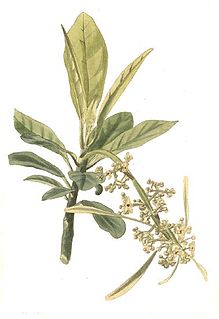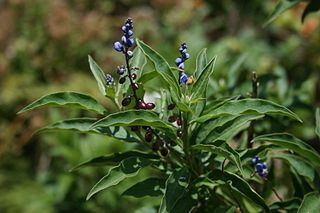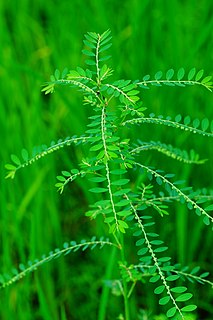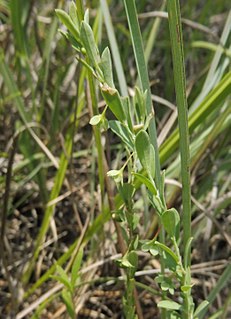
Phyllanthus is the largest genus in the flowering plant family Phyllanthaceae. Estimates of the number of species in this genus vary widely, from 750 to 1200. Phyllanthus has a remarkable diversity of growth forms including annual and perennial herbs, shrubs, climbers, floating aquatics, and pachycaulous succulents. Some have flattened leaflike stems called cladodes. It has a wide variety of floral morphologies and chromosome numbers and has one of the widest range of pollen types of any seed plant genus.

Phyllanthaceae is a family of flowering plants in the eudicot order Malpighiales. It is most closely related to the family Picrodendraceae.

Phyllanthus emblica, also known as emblic, emblic myrobalan, myrobalan, Indian gooseberry, Malacca tree, or amla from Sanskrit amalaki is a deciduous tree of the family Phyllanthaceae. It has edible fruit, referred to by the same name.

Omphalea is a plant genus of the family Euphorbiaceae first described as a genus in 1759. It is native to tropical parts of the Americas, the West Indies, Asia, Australia, and Africa.

Breynia is a plant genus in the family Phyllanthaceae, first described in 1776. It is native to Southeast Asia, China, the Indian Subcontinent, Papuasia, Australia, and the island of Réunion.

Disocactus phyllanthoides, the nopalxochitl or German empress, is a species of flowering plant in the cactus family Cactaceae. It is commonly grown as an ornamental houseplant. It is one of the three major species involved in creating the widely grown epiphyllum hybrids or "epis". The others are Disocactus speciosus and Epiphyllum crenatum.
Grias haughtii is a species of woody plant in the family Lecythidaceae. It is found only in Colombia in non-flooded lowland forests.
Glochidion raivavense, also known by its synonym Phyllanthus raivavense or by the local name mahame on the island of Tubuai, is a species of plant in the family Phyllanthaceae. It is endemic to the Austral Islands in French Polynesia, where it is native to the islands of Rurutu, Tubuai, and Raivavae.
Metalepis haughtii is a species of plant in the family Apocynaceae. It is endemic to Ecuador. Its natural habitat is subtropical or tropical moist lowland forests. It is threatened by habitat loss.

Monnina is a genus of flowering plants in the family Polygalaceae. There are 150 to 200 species distributed throughout the Americas from the United States to Patagonia.
Monnina haughtii is a species of plant in the family Polygalaceae. It is endemic to Ecuador.
Phyllanthus revaughanii is a species of flowering plant in the family Phyllanthaceae, native to the Mascarene Islands and the Mozambique Channel Islands. Its natural habitat is rocky shores.
Phyllanthus sponiifolius is a species of plant in the family Phyllanthaceae. It is native to Colombia and Ecuador. Its natural habitat is subtropical or tropical moist montane forests.
Rinorea haughtii is a species of plant in the Violaceae family. It is endemic to Colombia.

Phyllanthus niruri is a widespread tropical plant commonly found in coastal areas, known by the common names gale of the wind, stonebreaker or seed-under-leaf. It is a relative of the spurges, belonging to the genus Phyllanthus of the family Phyllanthaceae. It is called Bhuaamla in Hindi.

Phyllanthus polygonoides, known as smartweed leaf-flower or knotweed leafflower, is an herbaceous perennial plant in the family Phyllanthaceae. It grows from 10 to 50 centimeters in height. It is native to the United States and northern and central Mexico.

Phyllanthus reticulatus is a plant species described Jean Louis Marie Poiret; it is included in the family Phyllanthaceae.
The botanical name Phyllanthus distichus may refer to:
P. seemannii may refer to a few different species of plant. The specific epithet seemannii refers to someone with the surname 'Seemann,' in many cases it's botanist Berthold Carl Seemann (1825–1871).

Phyllanthus calycinus, known as false boronia and snowdrop spurge, is a small shrub in the family Phyllanthaceae, which grows to heights from 20 cm to 1.2 m, often on sandy soils. It is found in both Western Australia and South Australia. In Western Australia its white-cream to pink flowers may be seen from June to January, and in South Australia, from May to October.










